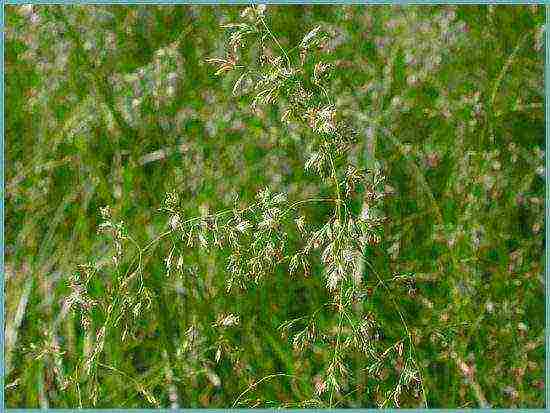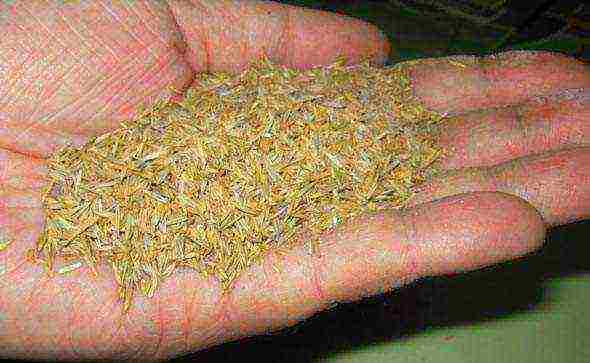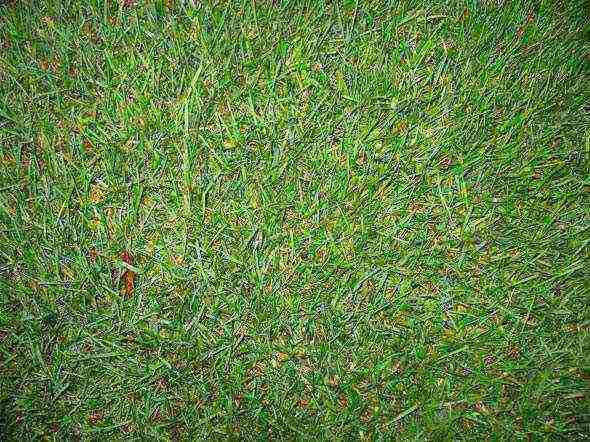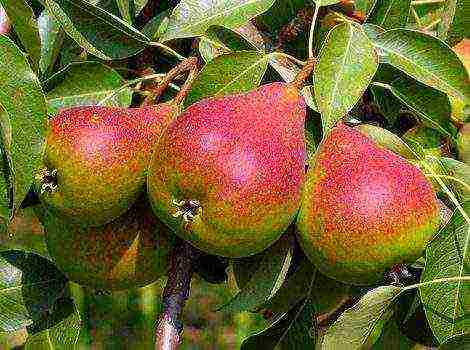Meadow bluegrass variety: Avord
Included in the State Register for the Russian Federation. Anthocyanin coloration of the leaf sheath is absent or very weak, hairs along the edge and on both sides below the leaf blade are absent or very sparse, on the tongue ...
Meadow bluegrass variety: Alicia
Included in the State Register for the Russian Federation. Anthocyanin coloration of the leaf sheath is absent or very weak, hairs along the edge of the sheath and on both sides below the leaf blade are absent or very sparse, on ...
Meadow bluegrass variety: Balin
Approved for use as lawn grass in the Russian Federation. The anthocyanin coloration of the leaf sheath is weak. The leaf is wide in the fall of the year of sowing. The inflorescences are sprinkled early. The stem, including the inflorescence, is long. According to…
Meadow bluegrass variety: Bluechip
Included in the State Register for the Russian Federation. The anthocyanin coloration of the leaf sheath is absent or very weak, the hairs along the edge are absent or very sparse, on the tongue they are absent or very short. Pubescence on ...
Bluegrass Variety: Broadway
Approved for use as lawn grass in the Russian Federation. The anthocyanin coloration of the leaf sheath is weak. Leaf in the fall of the year of sowing is medium to wide. The flag leaf is short to medium, narrow to ...
Meadow bluegrass variety: Vagant
Included in the State Register for the Russian Federation. Anthocyanin coloration of the leaf sheath is absent or very weak, hairs along the edge are absent or very sparse, on both sides below the leaf blade - absent or ...
Meadow bluegrass variety: Visim
Included in the State Register for the Russian Federation. Anthocyanin coloration of the leaf sheath is absent or very weak, hairs along the edge of medium density, on both sides below the leaf blade are absent or very rare, ...
Meadow bluegrass variety: Geisha
Included in the State Register for the Russian Federation. The anthocyanin coloration of the leaf sheath is absent or very weak, the hairs along the edge of the sheath are of medium density, on both sides below the leaf blade of medium density, they are dense, ...
Meadow bluegrass variety: Geronimo
Approved for use as lawn grass in the Russian Federation. The anthocyanin coloration of the leaf sheath is absent or very weak. The sheet is wide. Green to dark green leaf. The length of the flag leaf is from short to ...
Meadow bluegrass variety: Gift
Included in the State Register for the Russian Federation. The anthocyanin coloration of the leaf sheath is medium, the hairs on the edge and on both sides below the leaf blade are sparse, on the tongue they are of medium length. Pubescence on the upper ...
Meadow bluegrass variety: Pearl
Included in the State Register for the Russian Federation. The anthocyanin coloration of the leaf sheath is weak, the hairs along the edge and on both sides below the leaf blade are absent or very rare, on the tongue they are absent or ...
Meadow bluegrass variety: Impact
Included in the State Register for the Russian Federation. Anthocyanin coloration of the leaf sheath is absent or very weak, hairs along the edge and on both sides below the leaf blade are absent or very sparse, on the tongue ...
Meadow bluegrass variety: Istok
Included in the State Register for the Russian Federation. The anthocyanin coloration of the leaf sheath is weak, the hairs along the edge are absent or very sparse, on both sides below the leaf blade are absent or very sparse, on the tongue ...
Meadow bluegrass variety: Kartashevsky
Bred in the Northwestern Research Institute of Agriculture by the method of individual selection using cloning from the Altai wild sample K-37953. The bush is upright, of medium density. The plant is 65-87 cm high. Bushiness is average - 60-300 shoots per bush….
Meadow bluegrass variety: Carpet
Included in the State Register for the Russian Federation.Anthocyanin coloration of the leaf sheath is absent or very weak, hairs along the edge and on both sides below the leaf blade are absent or very rare, on ...
Meadow bluegrass variety: Carpet
Included in the State Register for the Russian Federation. The anthocyanin coloration of the leaf sheath is weak, the hairs along the edge and on both sides below the leaf blade of medium density, on the tongue are short. Pubescence on the upper ...
Meadow bluegrass variety: Compact
Approved for use as lawn grass in the Russian Federation. The anthocyanin coloration of the leaf sheath is absent or very weak. The leaf is wide, green. The flag leaf is short to medium, of medium width. Sweeping time ...
Bluegrass Variety: Connie
Approved for use as lawn grass in the Russian Federation. The anthocyanin coloration of the leaf sheath is strong. The type of bush in the fall of the year of sowing is medium to semi-horizontal. The color of the leaf is light green. Narrow to medium leaf….
Meadow bluegrass variety: Limagi
Included in the State Register for the Russian Federation. The anthocyanin coloration of the sheath is strong. The hairs along the edge of the leaf sheath are thick - very thick, on both sides below the leaf blade - very thick, on ...
Bluegrass Variety: Limerick
Included in the State Register for the Russian Federation. The anthocyanin coloration of the leaf sheath is very weak - weak, the hairs along the edge and on both sides below the leaf blade are sparse, on the tongue - short. Pubescence ...
Bluegrass Variety: Limousine
Approved for use as lawn grass in the Russian Federation. The anthocyanin coloration of the leaf sheath is absent or very weak. The color of the leaf is dark green. Narrow to medium leaf. Flushing of inflorescences in the second year is average ...
Bluegrass Variety: Lincolnshire
Included in the State Register for the Russian Federation. The anthocyanin coloration of the sheath is absent or very weak. The hairs along the edge of the leaf sheath and on both sides below the leaf blade are medium - thick, on ...
Bluegrass cultivar: Markus
Included in the State Register for the Russian Federation. The anthocyanin coloration of the leaf sheath is weak - medium, the hairs along the edge of the sheath and on both sides below the leaf blade are sparse - of medium density, on the tongue ...
Meadow bluegrass variety: Miracle
Included in the State Register for the Russian Federation. Anthocyanin coloration of the leaf sheath is from strong to very strong, hairs along the edge are absent or very sparse, dense on both sides below the leaf blade, on ...
Bluegrass Variety: Newglade
Included in the State Register for the Russian Federation. Anthocyanin coloration of the leaf sheath is absent or very weak, hairs along the edge and on both sides below the leaf blade are absent or very sparse, on the tongue ...
Bluegrass Variety: Oxford
Included in the State Register for the Russian Federation. The anthocyanin coloration of the leaf sheath is weak, the hairs along the edge and on both sides below the leaf blade of medium density, on the tongue are short. Pubescence on the upper ...
Meadow bluegrass variety: Panduro
Approved for use as lawn grass in the Russian Federation. The anthocyanin coloration of the leaf sheath is very weak to weak. Type of bush in the fall of the year of sowing semi-upright to intermediate. Leaf color is green to ...
Meadow bluegrass cultivar: Parsifal
Included in the State Register for the Russian Federation. The anthocyanin coloration of the sheath is absent or very weak. The hairs along the edge of the leaf sheath are sparse, on both sides below the leaf blade are sparse - medium, on ...
Bluegrass cultivar: Platini
Included in the State Register for the Russian Federation. The anthocyanin coloration of the leaf sheath is absent or very weak, the hairs on both sides are below the leaf blade of medium density, on the tongue are short. Pubescence on the upper ...
Meadow bluegrass variety: Pobeda
It was bred at the Morshansk breeding station by the method of group selection, followed by double mass selection with free intervarietal cross-pollination from the scandia cultivar. The bush is erect, dense, the stem is round, thin, of medium coarseness, 57-92 high ...
 The organization of a lawn on a personal plot is a fairly new practice for many Russians. A couple of decades ago, residents of private houses planted every square centimeter of soil with vegetables, roots, berries and herbs. Today people are trying to equip a recreation area with lawn grass, a gazebo, a barbecue and a swing near the house. There you can relax with family, friends and take great photos. Judging by the reviews and taking into account the domestic climatic conditions, meadow bluegrass is best suited for Russian lawns. Moreover, it is also edible: its early sprouts can be added to salad or given to cats and dogs.
The organization of a lawn on a personal plot is a fairly new practice for many Russians. A couple of decades ago, residents of private houses planted every square centimeter of soil with vegetables, roots, berries and herbs. Today people are trying to equip a recreation area with lawn grass, a gazebo, a barbecue and a swing near the house. There you can relax with family, friends and take great photos. Judging by the reviews and taking into account the domestic climatic conditions, meadow bluegrass is best suited for Russian lawns. Moreover, it is also edible: its early sprouts can be added to salad or given to cats and dogs.
Description and features of the plant
Meadow bluegrass is a cereal plant. It has a stern and slender stem that stands upright. The thin leaves of this herb also grow vertically. In summer, inflorescences appear on the stalks that look like spikelets. Bluegrass grows very actively. When mowing, and this should be done when the grass reaches 4 cm, the bluegrass begins to grow even thicker and more intensively. In general, the plant grows up to 10 cm in height, and some species grow up to 50 cm.
At the same time, mowing is very easy, the lines are smooth and neat. After such treatment, the plant quickly "tightens" the areas not overgrown before. Under this grass, the ground remains flat and soft, and does not form clumps, as it happens under other plants. Therefore, meadow bluegrass has earned such popularity precisely as a grass for the lawn.

Meadow bluegrass - cereal plant
Its second indisputable advantage is resistance to almost everything. Meadow bluegrass is not afraid of cold, wind, or temperature fluctuations, which are not uncommon for Russia. These plants are not susceptible to parasites, diseases and putrefactive manifestations.
Varieties and types
In botany, there are more than 10 species of meadow bluegrass. They "settle" on the site for up to 10 years. The most popular varieties of this lawn grass:
- Midnight - Not subject to trampling, which is why they are often seeded with football fields, sports fields, golf courses and parks.
- Boutique - grass that grows very densely, goes well with other varieties and types of lawn plants.
- Sobra - grows evenly and tolerates drought well.
- Dolphin is a low-growing variety of dark green grass.
- Panduro - has a high decorative value, immune to disease.
- Geronimo is a variety with bright grass, resistant to wear, and grows densely.
- Platini is fast growing.
Advice. When choosing the right variety, you should take into account the soil where it will be planted, as well as the climatic conditions of the region.
How to choose seeds
Sellers today offer a lot of grass mixtures, where the percentage of meadow bluegrass seeds does not exceed half. But a really good lawn can only be obtained by sowing a monoculture, that is, seeds of 100% uniformity.
You need to choose high-quality seeds according to the following parameters:
- seed characteristics: slope, influence of groundwater, soil quality, the need for sunlight and shade, etc.
- the seeds must have the relevant documents - quality certificates;

Meadow bluegrass seeds
- adaptability to a specific climatic zone;
- lawn type: grass for use (sports, outdoor activities) or decorative function.
Advice. Before sowing the entire lawn, it is worth buying a small amount of seed and trying them on a small piece of land - 1 m².
Sowing and care
Sowing meadow bluegrass is not an easy task. Therefore, you need to prepare well for it. First of all, you need to properly process the soil under the lawn.
- The earth must be dug up, stones, weeds must be removed, large lumps of soil must be broken. The fertile layer must be at least 15 cm.If it is not enough, the surface of the earth should be covered with sand.
- After that, the territory is leveled. This is done with a rake, after which the soil is compacted with a special roller. It can be replaced with a flat wooden board.
- Immediately before planting, the soil is loosened with a rake to a depth of no more than 2 cm. This should completely eliminate lumps and all the unevenness of the territory.

With regular mowing, your lawn will grow more actively
Now you can start sowing and caring for your lawn:
- It is best to sow meadow bluegrass with a special seeder, so the lawn will be more uniform. If there is no such equipment, you can also use the manual method. In this case, you need to scatter 40 g of seeds per 1 m².
- After that, the seeds must be distributed with a rake, and the soil must be fertilized with nitrogen and potassium.
- Until the bluegrass sprouts well, they need to be watered daily for 10 minutes. Also, the lawn needs to be watered during the summer drought.
- The optimum grass height is 4 cm. From this length, you should start cutting the grass and monitor its uniformity.
Meadow bluegrass grows quickly, is easy to care for, its separate plus is resistance to climate change. If you follow the recommendations listed above, then a personal plot with this grass will look like a lawn near the house of an American millionaire.
Lawn care tips: video
Meadow bluegrass: photo



Bluegrass is traditionally considered fodder and is planted in fields for hay and silage. Recently, this plant has been actively used in landscape design. On a personal plot, bluegrass can be planted as a ground cover crop. However, gardeners have noticed other useful properties. With proper agricultural technology, bluegrass is an excellent alternative to other types of green manure. Roa is especially good for spring sowing as a mulching material.
This article presents the common types of bluegrass grass and their botanical features. Knowing these subtleties, you can choose the right plants for your personal plot and use their properties for the benefit of fertility. Information about the plant is presented: how it looks and in what conditions it grows.
Look further at the photo and description of the bluegrass, and this will help you freely navigate in its varieties:
What a bluegrass plant looks like: description and photo
Bluegrass is a plant of the Cereals family. Starting the description of the bluegrass, it should be said that the genus has up to 200 species, distributed mainly in zones with temperate and cold climates. It is often confined to plant communities of meadows, steppes and bogs, serving as one of the main components in them. The species of the genus are of particular interest as forage grasses; some species are cultivated.
Perennial. The bluegrass plant is characterized by the presence of a short rhizome. The bluegrass stem can be of different lengths, from small, twenty centimeters, to one meter. The leaf blades are of the order of two to six millimeters in width, their upper side is sharply rough. The color of the grass stand is bright green. The panicles of the common bluegrass are spreading, their branches are thin, and the length of the panicle itself reaches twenty centimeters.
Continuing the description of the bluegrass plant, we note that it has good resistance to temperature drop, shade tolerance, and relatively easily recovers after trampling. At the same time, bluegrass makes high demands on the composition of the soil and the level of moisture. After mowing, regrowth is very slow. Propagated by seeds. It is very difficult to imagine what a bluegrass looks like, so it's better to look at the illustrations, which are presented in large numbers on this page.
See what the bluegrass grass looks like in the photo, where all the botanical structural parts are shown:
Bluegrass species
There are different types of bluegrass, so it is worth stopping to deal with at least some of them.
Marsh bluegrass (Poa palustris L.).
Perennial.Grain grass with a creeping rhizome forming tufts.
Stems are thin, smooth, ascending at the base. The height of well-leafy stems is up to 100 cm. The leaves are narrow-linear, flat or folded lengthwise, up to 3 mm wide, slightly rough. Leaf sheaths are smooth. The uvula, located at the border of the lamina and the vagina, is up to 3 mm long, narrowed in the upper part, split.
Inflorescence - panicle up to 20 cm long and 8 cm wide. During flowering, the panicle is spreading, after flowering - compressed. The branches of the panicle are rough, extending in the lower part from the main axis along 5. The panicle is multi-spikelet, the spikelets sit singly on the legs of its branch. Spikelets 2-3-flowered, no longer than 5 mm, color green or purple with a golden margin of the scales at the top. Covering scales are almost identical in length, lanceolate, pointed. The lower floral scales are pubescent along the keel and indistinct lateral veins, at the base with tufted hairs. The upper floral scales are scarious and shorter than the lower ones. The fruit is a weevil, spindle-shaped, up to 1.5 mm long. Seeds are light brown, triangular. The mass of 1 thousand seeds is 0.3 g.
It grows in damp meadows, river valleys, meadow bogs, along the edges of forests, in sparse birch-aspen and larch forests, in pine forests of forest and forest-steppe zones.
In relation to water, it is a transitional plant from mesophytes to hygrophytes. Demanding for moisture, tolerates long-term flooding (up to 30 days), but does not tolerate stagnant water. Grain with a slow rate of development. It reaches full development only in the third year after sowing. Late ripening, develops slowly in spring, blooms in July, seeds ripen in August.
Marsh bluegrass is used in the culture of Western countries. It grows well in floodplains of rivers with prolonged flooding, silty sediments, in semi-swamp and wet swampy places. The plant is hay and pasture.
See what the marsh bluegrass looks like in the photo, where its significant differences are demonstrated:
Narrow-leaved bluegrass (Poa angustifolia L.).
Long-rhizome perennial 40-60 cm high, with a creeping rhizome and numerous adventitious roots. Stems are erect. Stem leaves are bristly coiled, sometimes flat. Inflorescence - compressed, spreading panicle during flowering, 10-12 cm in length. Spikelets are 2-5-flowered. Blooms in late April - May, caryopses ripen in July - August.
Common plant in many habitats: steppe slopes, meadows, forest edges, bushes, drained meadows, roadsides. Grows sparsely with an abundance of 2-4. Forage valuable species - is considered one of the best forage plants for pastures in the temperate zone. Readily eaten by various types of livestock, both raw and dry. Well tolerates trampling and grazing. It is promising for creating lawns in arid conditions.
The narrow-leaved bluegrass in the photo of the plant demonstrates all its advantages and features:
Shumshuisky bluegrass (Snowy bluegrass) Poa shumushuensis Ohwi.
In Russia, it is also found mainly in the mountains of Kamchatka and in the south of the Magadan region. Occurs sporadically everywhere.
Perennial plant with long, very thin branching rhizomes. Stems 5.25 (35) cm tall, thin, smooth, shoots at the base with a few membranous sheaths of old leaves. Sheaths of stem leaves are closed 2/3 (3/4) of their length from the base. Leaf blades 1-2 (3) mm wide, thin, soft, flat or loosely folded, short-pointed, light green, smooth or slightly rough above; the tongue of the upper sheet is 0.5-1 (1.5) mm long. Panicles are 2-7 cm long, with few spikelets; branches of panicles are arranged, thin, smooth, with 1-2 spikelets. Blooms in July, fruiting in August.
Most of all it is associated with mountain streams, where it grows along mossy channels, less often on pebbles.
The herb belongs to cereals and grows everywhere in temperate zones and northern latitudes.A perennial crop has a taproot capable of producing lateral shoots. So the plant spreads over a larger area. The height of the soft stem is 30-90 cm. The first shoots appear immediately after the snow melts. This is one of the earliest cultures.
The narrow leaves, about 4 mm wide, grow vertically, encircle the stem and form a rosette. The plant begins to bloom only for 2-3 years. This happens 1 time per season from May to July. The inflorescence forms a panicle consisting of several loose spikelets. Spikelets can be 3-6 mm long, greenish-yellow or pale purple in color.
The meadow variety of this cereal belongs to a quality forage plant and has been introduced into cultivation. Meadows are sown with it for grazing and hay making. The best lawns and lawns are also created with this plant.
To make a lawn in a summer cottage, it is necessary to sow a clearing with this grass. She will always remain soft. At the same time, she is not afraid of cold and wind, she practically does not trample and does not require tedious care.
Meadow culture has long taken root in summer cottages, not only in Russia, but also abroad. There are even lawn fees, which include the seeds of this cereal. But it is better to acquire a monoculture: this will make the lawn uniform. There are different varieties of grassland:
- Midnight - used for soccer fields and golf courses;
- Blackberry - a dense, low-growing lawn for sports fields;
- Sobra - drought-resistant, suitable for a sports field and decorative lawn;
- Compact is a versatile variety with high wear and resistance rates;
- Geronimo - has a bright, saturated color, forms a dense "carpet".
An important advantage of the plant is resistance to trampling. But this applies to the already formed coating. You cannot run on a freshly sown field.
Sowing a lawn with a crop should be based on a ratio of 40 g of seeds per 1 m2. At the same time, it is necessary to sow both along and across, so that there are no "holes". The lawn should be watered daily before germination. When sprouts appear - watering as needed. During the season, you can feed the lawn 1-2 times.


